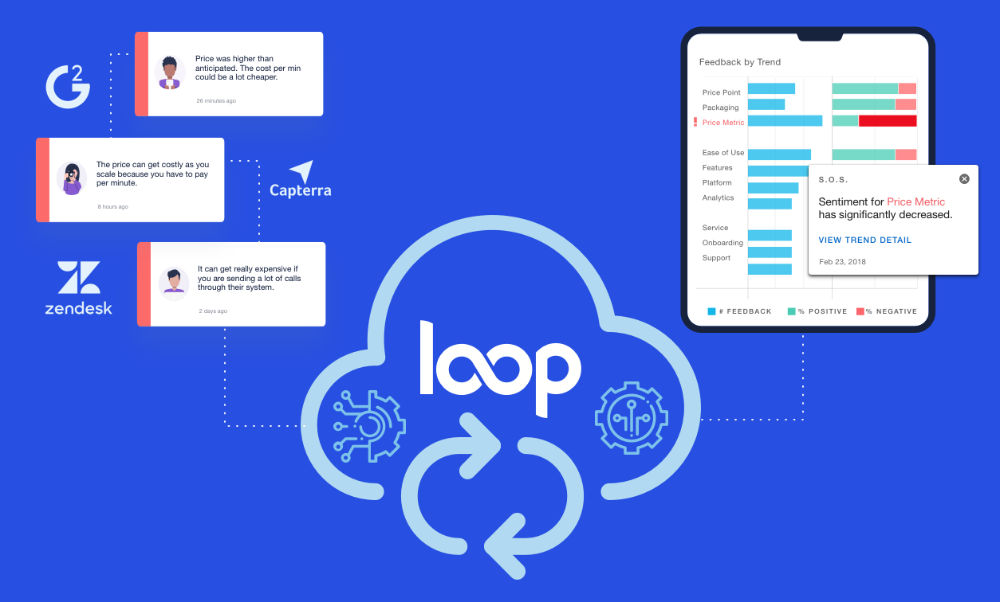Home » Five Key Reasons to Build a Voice of Customer Program
Five Key Reasons to Build a Voice of Customer Program
Madeline Turner

Every year, predictions circulate about the big trends that will change the game for SaaS companies.
The content drives clicks and inspires some new ways of thinking, but we all know that there is no silver bullet. We know that being singularly focused on one channel or activity won’t move the needle.
The more we learn, the more we understand that none of our well-thought strategies really matter if they don’t engage and motivate customers.
Our customers have more options than ever and it’s important to listen to the voice of the customer. If they’re not pleased with their experience, they can leave. This means that no matter what year it is, it’s always going to be the year of the customer. The companies that grow will be those that understand and act on this.
One of the best ways to build customer-focused strategies this year is to invest in a Voice of Customer (VoC) program. VoC programs break down silos across organizations and centralize customer feedback so that all departments have full visibility into the customer experience — and can align on actions that address issues or opportunities.
A VoC program isn’t your silver bullet, but it will position your team to deliver on customer wants and needs more quickly and help you improve the overall customer experience
Five reasons to implement a Voice of Customer program this year.
1. Voice of Customer Programs Reduce Churn
First, let’s dive into a few specifics of churn rates across the B2B SaaS industry. According to Recurly Research, the median monthly churn rate in 2018 for B2B SaaS companies was 4.67%.
A median monthly churn rate of nearly 5% is not good.
If we consider a monthly churn of 4.67% across a 12 month period, we’re looking at an annual churn rate of 44% (for more on calculating monthly and annual churn, this article by Joe York is great).
This rate of churn means that it’s impossible to grow. If it costs five times more to acquire a new logo than it does to retain an existing one—with these kind of industry churn rates—we’re essentially just burning cash to maintain status quo.
Imagine if we dedicated the same amount of resources to customer retention that we do to customer acquisition. We wouldn’t just have happier customers, we’d have better products, better company cultures (because it wouldn’t always be about filling the leaky bucket), and we’d have real growth.
Addressing Voluntary Customer Churn
There are two types of customer churn: voluntary and involuntary.
- Voluntary churn points to customer issues
- Involuntary churn points to payment issues
In this article, we’ll be focusing on voluntary churn. (If you’re interested in learning about addressing involuntary churn, ProfitWell has some good resources.)
The best way to address voluntary customer churn is to first understand why they’re leaving.
- What breakdowns are occurring in the customer experience?
- Are there product features missing that a competitor provides?
- Are your sales reps selling on price point rather than value?
- Are customers struggling to find success with your product because of ineffective onboarding?
- Do you have issues with product stability?
The list goes on. The point is, there may be several reasons that your customers are leaving, so the work is about drilling into customer feedback and user behavior to identify trends and signals. [If you’re a new company, understanding why customers leave isn’t just important to reduce churn, it’s important as you look to identify product market fit.]
Voice of Customer programs and technology are meant to give you a view of customer feedback at scale, across the entire organization. While Customer Success and Customer Support programs offer 1:1 assistance, VoC programs identify feedback trends across your entire customer base so that you can make high-impact decisions more quickly.
If we’re only focused on addressing customer churn when it’s time for renewals, we’re too late. Customer retention has to be a year-long focus of listening to customers, prioritizing their feedback and acting on it.
2. Voice of Customer Programs Increase Revenue
As discussed above, an important component to increasing revenue is fixing your leaky bucket. If you can’t retain the customers you have, you can’t grow.
Assuming that you are prioritizing customer retention, another benefit of a VoC program is that it gives you insight into where your customers place the most value.
Understanding how to improve your customer experiences allows you to structure your GTM, Upsell, and Cross-sell strategies based on what is most valuable to them. And focusing on delivering value to your existing customers can generate more revenue.
- The probability of selling to an existing customer is 60 – 70%, while the probability of selling to a new prospect is 5-20%.
- Existing customers are 50% more likely to try new products and spend 31% more, when compared to new customers.
Rather than investing in new logo acquisition strategies focused on replacing the customers you’ve lost, you can use VoC data to help retain the customers you have and grow MoM.
The democratization of customer data empowers organizations to solve problems and deliver solutions that will have the greatest impact across their customer base.
- Is there an opportunity to re-package products?
- Is there a need to differentiate offerings from new products entering the space?
- Do sales reps need to be trained on value-selling?
- Are there features missing that customers feel should be prioritized?
Once we understand the barriers customers may have to continued investment, we can focus on strategies to fix or address them.
3. Voice of Customer Programs Help SaaS Companies Build Better Products
Building a SaaS product that stands out in the B2B marketplace isn’t easy. Customer needs, technology, and competition are constantly changing—requiring constant product innovation.
The companies that thrive are those that are acutely attuned with the voice of customers and how they use the product today and how they will want to be using the product a year from now.
This level of synchronicity can’t happen without processes that keep customer feedback central to product development.
Oftentimes, however, the processes created to funnel customer feedback to product teams is slow and requires significant manual effort to sort through and label each piece of customer feedback. The work alone makes it difficult to respond to customer needs quickly.
Voice of the customer programs and technology offer a better way to incorporate customer feedback into every stage of the product development cycle. Solutions like LoopVOC use natural language processing to analyze customer feedback across channels in realtime and then serve up the major themes coming out of feedback.
This allows product teams to understand where there may be UX, UI, or platform issues impacting the customer experience:
- Ease of Use: How adaptable is the user interface? Does it take a lot of resources to understand how to use the tool?
- Features: Which capabilities of your product are most important to users? Which features are lacking? Missing altogether? Overkill?
- Platform: Has platform stability impacted customer retention? Are users looking for greater accessibility? More integrations? Greater security?
- Analytics: How well does your product interpret and visualize data into insights? How well can users build reports and search for the information they need?
If customers are having issues using your product, this pain point will impact their feedback related to onboarding (are they adequately trained to use the product?), support (are they getting the help they need when they run into issues using the product?), and even pricing (is usability impacting the value they’re receiving from the product?).
Understanding the root cause of customers’ product concerns is critical to charting a path forward to address the issue. Conversely, perhaps the issue or opportunity was known and accounted for on the product roadmap, but customer feedback offers the validation your team needs to reprioritize feature rollouts.
Voice of Customer programs help keep us accountable and guide us to addressing the highest-value features and fixes first.
4. Voice of Customer Programs Help Marketers Produce Better Content
There’s a difference between writing to your customers and writing for your customers. The former assumes that you are delivering a message that you feel is important while the latter assumes that you are delivering a message that benefits your customers.
The most compelling messages are those that are written for your customers. You can’t create content that resonates if you’re out of touch with the market you’re writing for or using marketing jargon that doesn’t mean anything to your customers.
In an overly stimulated world, creating great content is critical. And it’s not just because our attention spans are decreasing — it’s because our audience has options and they won’t waste time consuming content that doesn’t matter to them.
In Prezi’s state of attention report, 49% of respondents say they’ve become more selective about what they give their attention to in the past year.
One of the best ways to cut through the noise and deliver content that converts is to incorporate VoC copywriting.
Conversion Copywriter Andrew Yedlin shared an in-depth breakdown of how to put Voice of Customer Copywriting into practice in another article, but I’ll share some of the benefits and highlights of this approach with you below.
What are the benefits to a VoC copywriting approach?
- Dramatically cut the time it takes you to write effective messages and keep you from ever having to write from scratch
- Give you a repeatable process for finding the messages that are most likely to persuade your audience (instead of trying to dream them up on your own)
A voice-of-customer-driven approach to finding and writing high-impact messages takes your customers’ own words — from surveys, interviews, review sites and elsewhere — and mines them for messages that persuade and resonate with your prospects and customers.
This saves you from guessing what your audience needs to hear so that you can produce:
- More and better leads
- More paying customers
- Less churn
- And other growth outcomes
Whether it’s customer feedback from online review sites, verbatim feedback from NPS or CSAT surveys, CRM notes from win/loss calls, or messages they’ve shared on social media, this feedback is a goldmine of copywriting opportunity.
In Jennifer Havice’s book Finding the Right Message: How to Turn Voice of Customer Research into Irresistible Web Copy, she establishes 4 key aspects of your customers’ experience to explore in your VoC research:
- Motivations: What are their wants and needs?
- Pain points: What problems would they like to fix?
- Hesitations or anxieties: What concerns could stop them from taking action?
- Motivational triggers: What spurs them to take action?
Advanced software like LoopVOC collects and analyzes your VoC data to identify priorities as well as identify which motivations, pains, hesitations and triggers come up most frequently in their feedback.
Research has shown that a voice-of-customer-approach to copywriting improves results.
Split-test research was conducted to measure verbatim language in a headline from VOC research against a control headline.
The headline variation — with no other changes to the page — drove a 400% increase in clicks on the primary call to action button and over 20% more lead generation submissions on the following page.
A VOC-driven approach to content creation doesn’t just save you time. It improves your chances of success.
5. Actioning on Voice of Customer Data Promotes Brand Advocacy
It’s one thing to keep customers. It’s another thing to create advocates for your brand or product. This only happens when companies build authentic relationships with their customers and deliver on the promises they’ve made.
When asked about brand-building in 2020, David Srere stated:
“We live in a world where consumers are increasingly skeptical about the breakdown between what organizations say and what they do—and they’re not shy in expressing their dissatisfaction (in words and dollars!) with just a few clicks on their preferred device. In this environment, a significant opportunity is afforded to brands that lead with authenticity, that is, align their promises and their actions.”
The point is that your customer experience is your brand.
But according to a report by Bain and Company, 80% of companies surveyed believed they delivered a “superior experience” to their customers, while only 8% of customers surveyed reported that they were really delivering.
How can companies deliver an exceptional experience and build brand loyalty when there’s such a disconnect between company and customer?
Voice of Customer programs bridge this gap and empower companies with the information they need to create the experiences customers crave. But it takes more than just listening and understanding. Customers want to see the impact of their feedback.
Truly prioritizing the customer in 2020 means delivering on promises and prioritizing their needs. When we get this right and customers can see tangible outcomes from their feedback, they’ll be more invested in sticking around and promoting our products or services.
When you can prove to customers that your primary goal is mutual growth and success—that their feedback is a critical component to achieving this—you’ll differentiate yourself from the majority of the market.
If you focus on one major initiative in 2020, focus on building a Voice of Customer program that gives your customers a seat at the table. If you do this, you’ll:
- Increase customer retention
- Grow revenue
- Build better products
- Create better content
- Improve your net promoter score (NPS)
- And build brand loyalty



